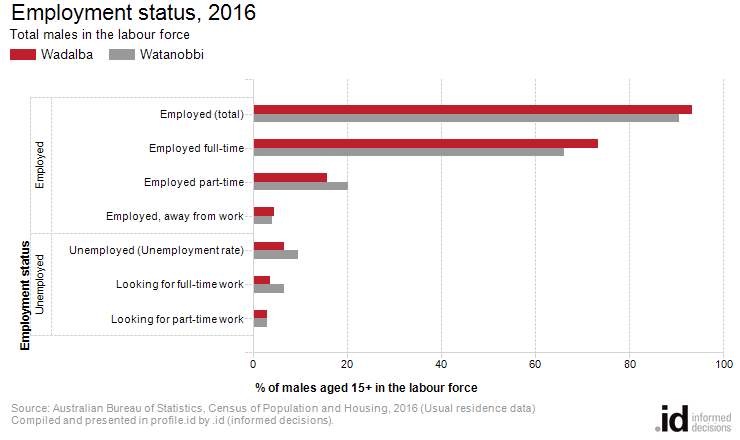Wadalba
Employment status
691 males living in Wadalba in 2016 were employed, of which 78% worked full-time and 17% part-time.
Wadalba's employment statistics are an important indicator of socio-economic status. The levels of full or part-time employment, unemployment and labour force participation indicate the strength of the local economy and social characteristics of the population. Employment status is linked to a number of factors including Age Structure, which influences the number of people in the workforce; the economic base and employment opportunities available in the area and; the education and skill base of the population (Occupations, Industries, Qualifications).
The two most important measures are:
- Unemployment rate - the number of people looking for work, as a percentage of the labour force (employed and unemployed over 15)
- Participation rate - the labour force expressed as a percentage of the total population over 15
Please note that in the 2021 Census, due to the COVID pandemic and lockdowns in many areas, the proportion of people who were employed but away from work in the week before Census has increased. We have no information on whether these people were normally employed full or part time so this is shown separately.
Derived from the Census question:
'Last week did the person have a full time or part time job of any kind?'
Persons aged 15 years and over
Source: Australian Bureau of Statistics, Census of Population and Housing (opens a new window) 2011 and 2016. Compiled and presented by .id (opens a new window)(informed decisions).
(Usual residence data)
Source: Australian Bureau of Statistics, Census of Population and Housing (opens a new window) 2011 and 2016. Compiled and presented by .id (opens a new window)(informed decisions).
(Usual residence data)

Compiled and presented in profile.id by .id (informed decisions).

Compiled and presented in profile.id by .id (informed decisions).
Dominant groups
The size of Wadalba's male labour force in 2016 was 740, of which 116 were employed part-time and 542 were full time workers.
Analysis of the male employment status (as a percentage of the labour force) in Wadalba in 2016 compared to Watanobbi shows that there was a higher proportion in employment, and a lower proportion unemployed. Overall, 93.4% of the male labour force was employed, and 6.6% unemployed, compared with 90.4% and 9.6% respectively for Watanobbi.
Analysis of the labour force participation rate of the male population in Wadalba in 2016 shows that there was a higher proportion in the labour force (72.1%) compared with Watanobbi (64.5%).
Emerging groups
Between 2011 and 2016, the number of males employed in Wadalba showed an increase of 257, and the number unemployed showed an increase of 13. In the same period, the number of males in the labour force showed an increase of 270 or 57.4%.
